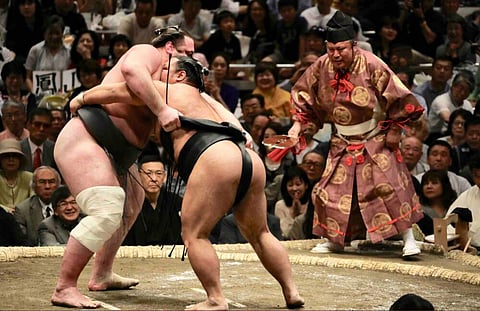

It is Japan's national sport, and while it may seem simple, there are countless techniques to learn for mastery of this Japanese Martial Art.
Sumo means "striking one another." Deeply rooted in tradition and religion, the first recorded match was in 23 BC making it one of the oldest sports in the world. Over time its popularity has survived from the Emperor's Court to public arenas.
The ring is made of clay and sand. One bout consists of one round. Only men area allowed to compete. Opponents throw salt to purify the ring and then crouch into position before lunging at each other with their fists. The aim is to force the opponent to the ground or outside the ring, and the winner is determined by the last man standing in the ring.
Unlike the general population, top division Japanese Sumo wrestlers weigh an average of 366 lbs. And yet, there is no weight class, so training in their stables includes weight gain for extra advantage. In order to achieve that weight and still maintain the required physical fitness, there are strict rules to follow in the daily life of a Sumo wrestler governing what time they wake up in the morning, to what they are allowed to wear. They must grow their hair long in order to form a top knot hair style. They are not allowed to drive cars—in part because for many it is not even physically possible. All these rules are aimed at enabling the wrestler to compete more effectively–with the one exception being the rule regarding women, which is that they are not allowed to compete in professional sumo at all.
Sumo wrestlers are actually not allowed to eat breakfast, but after a large lunch are expected to nap. Their traditional lunch is called chankonabe, which is available to the public at various restaurants in Tokyo. This hearty simmering stew consists of fish, chicken, meatballs and vegetables all cooked at the table in a richly flavoured broth. It is basically all the nutrition one might need, and in very large quantity.
Since Sumo wrestlers are ranked in six divisions, the year-end Fukuoka Grand Sumo Tournament in November is the last chance for a must-win performance, and therefore attracts serious attention and fanfare across Japan. Seating, divided into tatami mats around the ring and arena seats, are all prized and highly sought after.
The Osaka Grand Tournament is set to commence next week. Learn more and get your tickets here: https://www.sumo.or.jp/En/